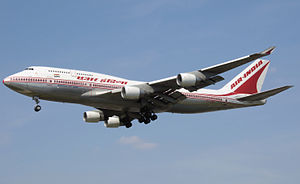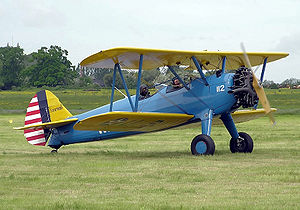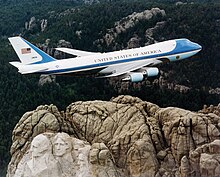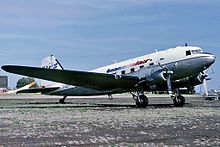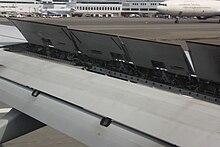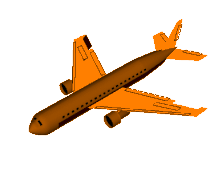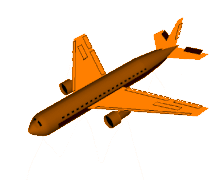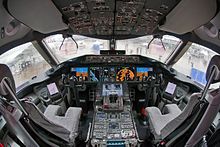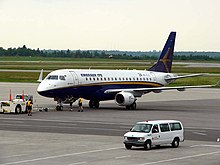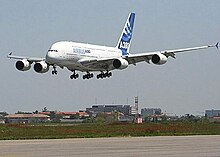Airplane
An airplane (from the French avion and this as an augmentative form of the Latin avis, ave), Also called aeroplane (from French aéroplane), it is a fixed-wing aerodyne, or aircraft with greater density than air, equipped with wings and a cargo space, and capable of flight powered by one or more engines. Airplanes include monoplanes, biplanes, and triplanes. Airplanes without an engine are called gliders or sailboats, and they have been used since the beginning of aviation, for the so-called sports aviation, and even for the transport of troops during World War II.
According to the AERO definition, it is an "engine-powered aircraft, which owes its lift in flight mainly to aerodynamic reactions exerted on surfaces that remain fixed under certain flight conditions".
They can be classified by their use as civil aircraft (which can be cargo, passenger transport, training, health, firefighting, private, etc.) and military aircraft (cargo, troop transport, fighters, bombers, reconnaissance or spies, in-flight refueling, etc.).
They can also be classified according to their power plant: aircraft powered by piston engines, jet engines (turbojet, twin-flow turbojet, turboprop, etc.) or propellants (rockets).
Its operating principle is based on the aerodynamic force that is generated on the wings, in an upward direction, called lift. This is caused by the pressure difference between the upper and lower part of the wing, produced by the shape of the wing profile.
History
The dream of flying dates back to prehistoric times. Many ancient legends and myths tell stories of flights like the Greek case of the flight of Icarus. Leonardo da Vinci, among other visionary inventors, designed an Airplane, in the 15th century. With the first human flight by François de Rozier and the Marquis of Arlandes (in 1783) in a lighter-than-air apparatus, a paper balloon built by the Montgolfier brothers, filled with hot air, the greatest challenge passed. to being the construction of a machine heavier than air, capable of taking flight under its own power.
Years of research by many people eager to achieve that courage, generated weak and slow, but continuous results. On August 28, 1883, John Joseph Montgomery was the first person to make controlled flight with a heavier-than-air machine, a glider. Other researchers who made similar flights at that time included Otto Lilienthal, Percy Pilcher, and Octave Chanute.
Sir George Cayley, who laid the foundations of aerodynamics, had already been building and flying prototypes of fixed-wing aircraft since 1803, and managed to build a successful passenger-carrying glider in 1853, albeit because it had no engines it could not be described as an "airplane."
The first aircraft itself was created by Clément Ader, who on October 9, 1890 managed to take off and fly 50 meters with his Éole. He later repeats the feat with the Airplane II flying 200 m in 1892 and the Airplane III in 1897 flying a distance of more than 300m. The Éole flight was the first self-propelled flight in the history of humanity, and is considered the start date of aviation in Europe.
According to the International Aeronautical Federation (FAI), on December 17, 1903, the Wright brothers made "the first sustained and controlled flight of an airship powered by an engine" for 12 seconds and in which they traveled about 36.5 meters.
A few years later, on November 23, 1906, Brazilian Santos Dumont was the first man to take off on board an airplane powered by an aeronautical engine, thus setting the first world record recognized by the Aéro-Club de France by flying 220m in less than 22 seconds. He flew a height of 2 to 3 meters above the ground with his 14-bis, in the Bagatelle field in Paris. Santos Dumont was thus the first person to fly a heavier-than-air aircraft under his own power, since the Kitty Hawk of the Wright brothers needed a catapult until 1908.
In 1911 the first seaplane appeared thanks to the American Glenn H. Curtiss; in 1913 the first four-engine, the "Le Grand", designed by the Russian Ígor Sikorski and in 1912, Juan Guillermo Villasana created the Anahuac propeller, made of wood.
After the First World War, engineers understood that the performance of the propeller had its limit and began to look for a new method of propulsion to reach higher speeds. In 1930, Frank Whittle patented his first centrifugal compressor turbine engines and Hans von Ohain did the same in 1935 with his axial compressor turbine engines. In Germany, on August 27, 1939, the Heinkel HE-178 that mounted an Ohain engine took off, making the first pure jet flight in history.
Structure
The airplanes best known and used by the general public are those for passenger transport, although general aviation and sports aviation are highly developed, especially in the United States. Not all aircraft have the same structure, although they have many common elements. Transport aircraft all use a semi-monocoque structure made of metallic materials or composite materials formed by a skin, generally aluminum, that supports aerodynamic and pressure loads and is stiffened by a series of structural elements and a series of longitudinal elements. Until the 1930s, the construction of wood or aluminum tubes covered with fabric was very common.
The structures of light aircraft or light sport aircraft are increasingly made of fiberglass and other composite materials.
The main components of aircraft are:
Fuselage
The fuselage is the body of the aircraft to which the wings and both horizontal and vertical stabilizers are attached. Its interior is hollow to accommodate the passenger cabin, control cabin and cargo compartments. Its size will obviously be determined by the design of the aircraft.
Airfoils
An airfoil is any surface designed to elicit a reaction force when in motion relative to the surrounding air. Two examples of airfoils are airplane wings or a propeller blade.
Wings
The wings, made up of an aerodynamic surface that provides lift to the plane due to the aerodynamic effect, caused by the curvature of the upper part of the wing (extrados) that causes the air that flows over it to accelerate and therefore therefore lowers its pressure (creating a suction effect), while the air that circulates under the wing (which in most cases is flat or with a lesser curvature and which we will call the intrados) maintains the same speed and pressure of the relative air, but at the same time the lift increases since when it affects the lower part of the wing it contributes to the lift, a force that counteracts the action of gravity.
It is known that at higher speeds there is less pressure in the air (Bernoulli's law)
The most important parts of a wing are:
a) Leading edge. It is the part of the wing that faces the wind when the plane is in flight, normally it has a rounded shape.
b) Trailing or trailing edge. It is the trailing part of the wing and is the last section to pass through the air, its shape is normally thin and flattened.
c) Camber. It is the curvature of a wing, it goes from the leading edge to the trailing edge.
The wing is composed of a main beam and a series of ribs. The beam supports the lift and load forces, the ribs fuse the wing so that it acquires an airfoil shape. The most used materials in the past were wood and fabric. Then aluminum began to be used and finally composite materials such as fiberglass and carbon.
The wings also house the fuel tanks. The reason why they are located there is so that they do not influence the longitudinal balance as the fuel wears out. They serve as counterweights when the wings begin to generate lift. Without these counterweights and in a loaded aircraft, the wings could easily detach during takeoff. Also on most commercial airplanes, the main landing gear is recessed into the wing, as are the engine mounts.
Control surfaces
In certain parts of a flight, the configuration of the wing is varied by means of the control or control surfaces found on the wings: the ailerons, present in all types of aircraft, plus others that are not always present, especially in lighter aircraft, although in larger ones: they are flaps, spoilers and slats. All of them are moving parts that cause different effects during the flight.
Ailerons
Ailerons are moving surfaces found at the wingtips and on the trailing edge of the wing. They are in charge of controlling the displacement of the airplane on its longitudinal axis by creating an aerodynamic imbalance of the wings, which is what allows the airplane to turn, since when the joystick is turned to the left the right aileron goes down, creating more lift on the right wing, and the left aileron rises, artificially detaching the laminar flow from the left wing and causing a stall on the left wing; the reverse occurs when we tilt the joystick to the right. All aircraft feature these primary control surfaces.
In addition, and depending on their size, the wings can carry the following devices:
Flaps
The flaps are high-lift devices that are located on the trailing edge of the wing; when they are retracted they form a single body with the wing. These are used in certain maneuvers (commonly takeoff and landing), in which they extend back and down the wing at a certain angle, increasing its curvature. This causes a reaction in the airfoil that induces more lift, or the same with lower speed; by making the laminar flow travel more distance from the leading edge to the trailing edge, thus providing more lift at low speeds and high angles of attack, at the same time the flaps generate more drag at the wing surface, so it is necessary to counteract it, either by applying more power to the engines or by decreasing the plane's angle of attack. This is by far the most common high lift device.
In addition to these, and from a certain size of aircraft, there may be the following high lift devices:
Spoilers
The spoilers are moving surfaces arranged on the extrados. Its function is to reduce the lift generated by the wing when it is required, for example, to increase the rate of descent or at the moment of touching down. When they are extended, they prematurely separate the airflow that runs along the extrados causing the wing to stall, a controlled stall one could say.
In addition, by eliminating the lift generated by the wing, the weight of the aircraft falls on the wheels, causing the brakes –located on the landing gear– to take most of the braking load.
Aerodynamic brakes
Aerodynamic brakes are similar to spoilers with the only difference being that they don't cut off the airflow on the wing. Therefore they do not prevent lift but rather increase wind resistance which allows the aircraft to descend without accelerating. The aerodynamic brake protrudes above the wing profile unlike the spoiler.
Slats
The slats, like the flaps, are high lift devices; The difference is that the slats are located on the leading edge, and when they are extended they further increase the curvature of the wing, preventing the detachment of the boundary layer even with high angles of attack. that is, at reduced speeds.
Horizontal stabilizers
They are two surfaces smaller than the wings, always located in a horizontal position (generally at the rear of the fuselage, and in different positions and shapes depending on the design) that guarantee stability in the longitudinal direction; that is to say, they guarantee a constant angle of attack if the pilot does not act on the controls. In them there are some essential control surfaces that are called elevators, with which the longitudinal position of the apparatus is controlled, the basis of speed regulation. By moving these surfaces up or down, the aircraft is tilted up or down, which is called angle-of-attack control, that is, its position relative to the line of flight. This is the "pitch" movement.
Vertical stabilizers
It is/are a fin(s) that is/are located in a vertical position at the rear of the fuselage (usually at the top). Their number and shape must be determined by aeronautical calculations according to aerodynamic and design requirements, which provides directional stability to the aircraft. In this there is a very important control surface, the rudder, with which the flight course is controlled by moving towards one side or another of this surface, turning towards the determined side on its own axis due to effects streamlined. This effect is called a "yaw" motion.
Component action
Each of these components acts on one of the navigation angles, which in aeronautical engineering are called Euler angles, and in geometry, Tait-Bryan angles. The perpendicular axes with respect to which the turns are made in each direction are the main axes of the airplane, and the particular movements are called roll (alternate vertical oscillation of the wings), pitch b> (alternating vertical oscillation of nose and tail) and yaw (alternating horizontal oscillation of nose and tail).
Powertrain
They are the devices whose function is to generate the necessary traction to counteract the aerodynamic resistance that is generated precisely by lift. These engines are extensively developed and tested by their manufacturer. In the case of airplanes without an engine or gliders, the traction is obtained by the gravity component according to the glide coefficient.
Within the powertrain there is a function called reverse that serves to reverse the thrust of the engine and allow it to brake more effectively during the landing roll. This functionality is possessed by high-performance aircraft equipped with jet or turboprop engines. Once the airplane has touched down on the runway and is rolling at high speed, the pilot activates reverse, a mechanical mechanism causes the air from the engines that was released to the rear to now exit in the opposite direction and contribute to the braking of the aircraft. airplane.
Landing Gear
Landing gear are devices, either fixed (light aviation) or mobile and retractable so that the aircraft moves on land, which is not its natural element. They allow the aircraft to have mobility on the ground. There are several types of landing gear, but the most used today is the tricycle, that is, three components, one in the front and two in the wings and part of compartments inside the wing and fuselage protected by covers. of the same ones that become part of the aircraft. In the event that the trains remain in the open position, they would generate great aerodynamic resistance to the aircraft, reducing its performance and speed, causing greater use of fuel. Not all planes have the ability to retract their trains, especially the lightest and most economical ones, even for passenger transport.
Control instruments
They are both mechanical and electronic (avionics) devices that allow the pilot to have knowledge of the main flight parameters, such as speed, height, course, rate of climb or descent, and the status of the aircraft systems during the flight, such as the engines, the hydraulic system, the electrical system, the weather conditions, the scheduled course of the flight, the route followed.
Commercial aviation
Commercial aviation is an activity carried out by airlines, dedicated to the air transport of either people or merchandise. In 1919 the first airlines were born, KLM (October 7 - Netherlands) in Europe and Avianca (December 5 - Colombia) in America.
It is the purpose of the flight, not the type of aircraft or the pilot, that determines whether a flight falls into the category of "commercial aviation." Thus, a Cessna 150 operating as an air taxi may be considered commercial aviation while an Airbus A319 ACJ used by its owners is considered private transport.
Passenger transport planes, also called commercial planes, are those that airlines use explicitly for the transport of passengers. They are usually divided into two categories; single-aisle or narrow-body aircraft with a fuselage diameter between 3 and 4 meters wide and twin-aisle or wide-body aircraft with a fuselage between 5 and 6 meters.
One of the best-selling single-aisle aircraft in the world is the Boeing 737. The passenger aircraft with the largest passenger transport capacity is the Airbus A380, an aircraft that can carry around 800 people, instead of the approximately 500 that carry a 747. The Boeing 747 was first introduced in 1969.
However, the largest airplane ever built dates back to the 1940s and was designed by aviation magnate Howard Hughes. Called Hercules H4, or simply "Spruce Goose" it is the seaplane with the largest wing span and height in the world. Powered by 8 propeller engines, this aircraft only made its maiden flight, with Howard Hughes as pilot. This aircraft is currently in relatively good condition at the Evergreen Aviation Museum.
The world's largest in-service airplane is the Antonov An-225 Mriya, built in the Soviet Union in 1988. This aircraft is considered a relic because only one has been built due to the fall of the Soviet Union.
Contenido relacionado
Peeps
CD-R
Assembler
